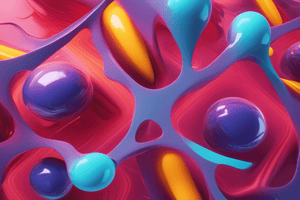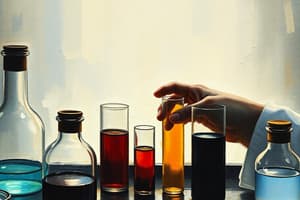Podcast
Questions and Answers
Dè a th’ ann an cromatagrafaíocht?
Dè a th’ ann an cromatagrafaíocht?
- Dòigh air puingean goileachaidh stuthan a thomhas.
- Dòigh air measgachadh de dhà stuth no barrachd a sgaradh. (correct)
- Dòigh air dùmhlachd stuthan a mheudachadh.
- Dòigh air co-phàirtean fìor-ghlan a shìoladh.
Dè na diofar sheòrsaichean de chromatagrafaíocht a th’ ann, a rèir nàdar nan ìrean?
Dè na diofar sheòrsaichean de chromatagrafaíocht a th’ ann, a rèir nàdar nan ìrean?
- Cromatagrafaíocht àrd-choileanadh agus ìre àbhaisteach.
- Cromatagrafaíocht cruaidh-liofta, liofta-liofta, agus gas-liofta. (correct)
- Cromatagrafaíocht colbh, pàipear, agus gas.
- Cromatagrafaíocht gas-gas, liofta-liofta, agus cruaidh-chruaidh.
Dè am prionnsabal bunaiteach air a bheil a h-uile dòigh cromatagrafaíoch ag obair?
Dè am prionnsabal bunaiteach air a bheil a h-uile dòigh cromatagrafaíoch ag obair?
- Sgaoileadh eadar-dhealaichte stuthan a rèir an solubility. (correct)
- A’ cleachdadh dealan gus na stuthan a sgaradh.
- Goil a’ mheasgachaidh aig diofar teodhachd.
- Daonnan a’ cur cuideam air a’ mheasgachadh.
Dè a th’ ann an Rf ann an cromatagrafaíocht?
Dè a th’ ann an Rf ann an cromatagrafaíocht?
Carson a tha feum air cromatagram a ‘nochdadh’?
Carson a tha feum air cromatagram a ‘nochdadh’?
Dè na prìomh phàirtean a th’ ann an cromatagrafaíocht còmhdach tana (TLC)?
Dè na prìomh phàirtean a th’ ann an cromatagrafaíocht còmhdach tana (TLC)?
Dè a th’ ann an eluente ann an cromatagrafaíocht?
Dè a th’ ann an eluente ann an cromatagrafaíocht?
Dè na buannachdan a th’ ann an cromatagrafaíocht còmhdach tana a thaobh cosgais agus astar?
Dè na buannachdan a th’ ann an cromatagrafaíocht còmhdach tana a thaobh cosgais agus astar?
Dè a’ phrìomh adhbhar a tha aig destileadh?
Dè a’ phrìomh adhbhar a tha aig destileadh?
Dè na dà theirm chudromach a tha air an cleachdadh ann am pròiseas destileadh?
Dè na dà theirm chudromach a tha air an cleachdadh ann am pròiseas destileadh?
Dè a thachras do mholéculaichean lionn faisg air a’ chrìoch ceò-lionn?
Dè a thachras do mholéculaichean lionn faisg air a’ chrìoch ceò-lionn?
Dè a tha a’ dearbhadh àireamh de mholéculaichean ann an ceò?
Dè a tha a’ dearbhadh àireamh de mholéculaichean ann an ceò?
Dè a tha lagh Raoult a’ mìneachadh?
Dè a tha lagh Raoult a’ mìneachadh?
Dè an seòrsa sampall a bhios nas freagarraiche airson destileadh le brùthadh nas ìsle?
Dè an seòrsa sampall a bhios nas freagarraiche airson destileadh le brùthadh nas ìsle?
Dè an diofar eadar destileadh simplidh agus destileadh bloighteach?
Dè an diofar eadar destileadh simplidh agus destileadh bloighteach?
Dè a th’ ann an adhbhar colbh bloighteach ann an destileadh bloighteach?
Dè a th’ ann an adhbhar colbh bloighteach ann an destileadh bloighteach?
Dè a th’ ann an destileadh le snìomh ceòl?
Dè a th’ ann an destileadh le snìomh ceòl?
Dè a th’ ann an adhbhar snìomh ceòl ann an destileadh le snìomh ceòl?
Dè a th’ ann an adhbhar snìomh ceòl ann an destileadh le snìomh ceòl?
Nuair a tha measgaichean lionn cugallach, dè as fheàrr?
Nuair a tha measgaichean lionn cugallach, dè as fheàrr?
Carson a tha destileadh le snìomh ceòl cudromach ann an ceimigeachd organach?
Carson a tha destileadh le snìomh ceòl cudromach ann an ceimigeachd organach?
Flashcards
Cromatagrafaidh
Cromatagrafaidh
Dòigh air measgachaidhean de choimeasgaidhean organach a sgaradh le bhith a’ sgaoileadh eadar dà ìre.
Rf (co-mheas aghaidhean)
Rf (co-mheas aghaidhean)
Co-mheas astar anailit gu astar an t-sileadh ann an cromatagrafaidh.
Cromatagrafaidh còmhdach tana (TLC)
Cromatagrafaidh còmhdach tana (TLC)
Cromatagrafaidh adsorption a’ cleachdadh ìre stèidhichte de stuth-glanaidh air plàta.
grùdaireachd
grùdaireachd
Signup and view all the flashcards
Brùthadh smùide
Brùthadh smùide
Signup and view all the flashcards
Grùdaireachd bloighteach
Grùdaireachd bloighteach
Signup and view all the flashcards
Grùdaireachd sìmplidh
Grùdaireachd sìmplidh
Signup and view all the flashcards
Lagh Raoult
Lagh Raoult
Signup and view all the flashcards
Grùdaireachd tarraing le smùid
Grùdaireachd tarraing le smùid
Signup and view all the flashcards
Study Notes
- Practice No. 6 focuses on chromatography, a technique for separating mixtures of compounds based on their distribution between two phases: a stationary phase and a mobile phase.
- The goal is to understand the separation by chromatography for separation and identification.
Introduction to Chromatography
- Chromatography separates mixtures of organic compounds via distribution between two phases, one stationary and one mobile.
- Different types of chromatography exist depending on the nature of the two phases.
- Solid-liquid phases refer to column, paper, and thin-layer chromatography.
- Liquid-liquid phases refer to liquid chromatography.
- Gas-liquid phases refer to gas chromatography.
- All chromatographic techniques rely on differential solubility of substances with respect to the two phases.
Rf Value
- Rf (retention factor) is the ratio of the distance traveled by the compound to the distance traveled by the solvent front.
- Rf is calculated by dividing the distance from the original mixture to where the component traveled by the distance from the original mixture to the solvent front.
Thin Layer Chromatography (TLC)
- TLC is a solid-liquid adsorption chromatography, where a substance is adsorbed onto a solid surface
- The mobile phase is a solvent or solvent mixture
- Common adsorbents include alumina (aluminum oxide) and silica gel (silicic acid).
- The eluent (solvent) ascends via capillary action through the plate, separating components based on their affinity and solubility.
- The advantage of TLC is its speed and low cost.
- If mixture components are colorless, the chromatogram must be treated with a substance that reacts and produces color, which is called "revelado del cromatograma"
TLC Experiment - Materials
- Reactives include butanol, glacial acetic acid, water, and vegetable dyes.
- Materials include a chromatographic chamber, capillary tubes, TLC silica gel, small clamps, gloves, dyes, a pencil, and a ruler.
TLC Experiment - Procedure
- Mark a line 1 cm from the base of the TLC plate with a pencil.
- Use a microcapillary to apply a small drop of the sample (dye) at the marked line, allowing it to dry completely and repeating to concentrate the sample.
- The spot diameter should not exceed 2mm.
- Place 2-3 ml of the eluent (Butanol-Acetic Acid-Water 12:3:5) in the chromatographic chamber and cover.
- Place the plate in the chamber, ensuring the applied sample is above the eluent level.
- Allow the eluent to ascend via capillary action until it reaches approximately 3 mm from the top of the plate.
- Immediately remove the plate, mark the solvent front with a pencil, and let it dry in a ventilated area.
Practice No. 7 - Simple Distillation
- The process of distillation is when a liquid turns into vapor, then is condensed and collected.
- Distillation uses the terms vapor pressure and boiling point.
Vapor Pressure
- Vapor pressure of a liquid is the pressure exerted by its vapor when the vapor is in equilibrium with the liquid at a given temperature.
- A liquid has variable energy atoms or molecules.
Process
- When a molecule of the liquid is close to the liquid-vapor phase boundary, it can transition to the vapor phase if it has enough energy to overcome the forces holding it in the liquid phase.
- Some molecules exist in the vapor phase above the liquid.
- When these molecules approach the liquid's surface, they can enter the liquid phase and become part of the condensed phase.
- The molecule loses kinetic energy (slows down).
- Heating the liquid causes more molecules to enter the vapor phase; cooling the vapor phase reverses this process.
- When the system is in equilibrium, the rate of molecules escaping the liquid phase into the vapor phase is equal to the rate of molecules returning from the vapor phase to the liquid phase.
- The extent of this equilibrium is measured by vapor pressure.
Mixtures
- If the liquid phase contains two different components, the vapor above the liquid contains molecules of both.
- The number of molecules of a component in the liquid phase depends on its volatility and its molar fraction in the mixture.
- The amounts are related to the vapor pressure of each pure liquid.
- The vapor pressure of the mixture above the liquid is the sum of the two partial pressures, Raoult's Law.
- Ptotal = PA + PB, where PA = P°A * XA and PB = P°B * XB
- PA and PB are the partial pressures of A and B.
- PºA and P°B are the vapor pressures of pure A and B.
- XA and XB are the mole fractions of A and B.
- At atmospheric pressure (760 mmHg), the sum of the partial pressures equals 1 atm.
Types of Distillation
- Simple distillation
- Fractional distillation
- Steam distillation
- Reduced pressure distillation
- Simple distillation can separate mixtures with boiling points that differ by 70°C or more.
- Simple distillation can distill a pure component, but is used for separating ethyl alcohol from an alcoholic beverage.
Practice No. 8 - Fractional Distillation
- Fractional distillation is effective for purifying liquids stable at their boiling points.
Process of Fractional Distillation
- In fractional distillation, you have two components which exert their own vapor pressures.
- A fractionating column is used to lengthen the path between the distillation flask and the condenser.
- Vaporization and condensation occur within the column.
- Each cycle of vaporization-condensation equates to a simple distillation.
- The more cycles, the more enriched the vapor becomes with the more volatile element.
- The condensate will become less volatile, resulting in an effective separation.
- The more efficient the column, the more effective the distillation.
- Reactives include ethyl acetate and butyl acetate.
Practice No. 9 - Distillation by Steam Dragging
- Steam distillation separates slightly volatile organic substances that are insoluble in water.
- When mixtures of liquids that are not miscible, the distillation follows Dalton's law on partial pressures.
- When steam distillation is performed, two immiscible liquids (water and component to be separated) when heated will exert their own vapor pressure regardless of the other.
- As temperatures rise, a point is reached where the combination of both vapor pressures will equal atmospheric pressure, at which point, distillation will occur.
- Condensation of the vapor phase gives a mixture of two phases with aqueous and organic components.
- A compound with an elevated point of boiling may be distilled with an immiscible liquid as long as its vapor pressure is small.
- Compounds with elevated boiling points that decompose at or near their boiling points can be steam distilled at sufficiently low temperatures to prevent decomposition.
Studying That Suits You
Use AI to generate personalized quizzes and flashcards to suit your learning preferences.




